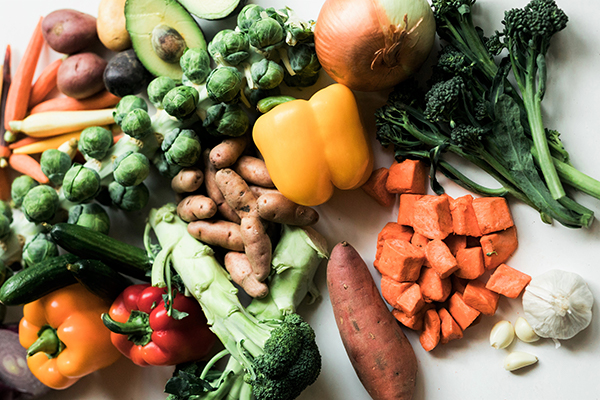Consuming a variety of vegetables every throughout the day is vital to healthy living.
Vegetables are nutrient-rich and high in vitamins, fiber and minerals. They also provide protection against various chronic diseases, including obesity, diabetes, and heart disease.
There are two primary kinds of vegetables: starchy and non-starchy vegetables. Types of starchy include corn, potatoes, and beans, while non-starchy varieties comprise tomatoes, broccoli and zucchini.
The primary difference between them lies in their proportion of starch, which is a kind of carbohydrate. But, they do contain a variety of other distinctions.
This article focuses on the advantages and main differences of starchy and non-starchy vegetables.
What are starchy and non-starchy vegetables?
Starch is the primary type of carbohydrate that you diet.
It’s commonly referred to as a complicated carb because it’s composed of several sugar molecules that are joined.

Starch is found in a wide variety of foods that include cereals, breads pasta, noodles, as well as starchy veggies.
However, most vegetables have very little starch, and can be classified into non-starchy.
In general cooked starchy vegetables like potatoes, contain approximately 15 grams of carbs and 80 calories for a 1 cup (70-90 grams) in comparison to non-starchy vegetables such as broccoli have around 5 grams of carbohydrates and 25 calories per equivalent amount.
US health organizations advise taking 2.5 cups of veggies each throughout the day — including non-starchy and starchy varieties.
Here are some examples of each of the groups:
Starchy Vegetables
- Beans (kidney pinto, navy black, cannellini, navy,)
- Butternut squash
- Chickpeas
- Corn
- Lentils
- Parsnips
- Peas
- Potatoes
- Sweet potatoes
- Taro
- Yams
Non-Starchy Vegetables
- Artichokes
- Asparagus
- Bean sprouts
- Brussels sprouts
- Broccoli
- Cabbage
- Cauliflower
- Celery
- Cucumber
- Eggplant (also called aubergine)
- Mushrooms
- Onions
- Peppers (also called capsicum)
- Salad greens
- Spinach
- Tomato
- Turnips
- Zucchini (also also referred to as courgette)
Both Are Rich in Nutrients
Each of starchy and non-starchy vegetables boast an impressive nutritional profile.
The amount of nutrients in a dish varies based on the kind of vegetable as well as the cooking methodused, all varieties naturally have an array of minerals and vitamins.
In reality vegetables are among the best foods that contain potassium and vitamin K as well as folate, and magnesium. These nutrients are crucial for heart health, bone health, well-being and pregnancy health.
The vegetables also have some of the other useful nutrients, like zinc and iron.
They’re also filled in antioxidants like vitamin C as well as E — both of which are substances that protect cells from harm due to free radicals as well as oxygenative stress
Thus antioxidants could fight ageing process, and also reduce the chances of suffering from chronic diseases such as cancer, heart disease and diabetes
Vegetables are also naturally low in fat, sugar and sodium, so you can eat them in a huge amount without having any adverse health consequences.
Both Are Rich in Fiber
Another feature shared by starchy and non-starchy vegetables is their high fiber amount.

The amount of fiber in a dish varies depending on the type of food, most starchy vegetables are a source of 46 percent fiber, which is around 2-4 grams per cup (70-90 grams) which is 6-14 percent of the recommended daily intake (RDI)
Certain starchy vegetables contain more. For instance, lentils, chickpeas and beans contain 8 to 5-8 grams of fiber for 1 cup (70-90 grams) which is 20-32 percent of the RDI
Additionally, non-starchy vegetables are also full of fiber. The majority of non-starchy vegetables have 2-3.5 percent fiber and 1.5-2.5 grams for a cup, which equals 7-10 percent of your daily requirements.
Fiber can keep your bowel movements regular. Research suggests that it can aid in preventing digestive problems like colon cancer and lower cholesterol and blood sugar levels, and the chance of suffering from cardiovascular disease as well as diabetes
In this regard it is important to eat a variety of starchy and non-starchy vegetables each every day is an excellent option to meet your fiber requirements and boost the overall health of your digestive system and overall.
Starchy Vegetables Are Higher in Carbs and Calories
Certain types of starchy vegetables , such as corn and potatoare causing controversy because of their high levels of starch.
While some feel that they shouldn’t be consumed at all the fact is that starchy vegetables contain various nutritious nutrients that can be an ideal supplement to your diet if taken in moderate quantities.
In comparison to non-starchy vegetables Starchy vegetables have higher amounts of calories and carbs.
Carbs
One major distinction the two starchy and non-starchy vegetables is their carb levels.
Starchy vegetables have 3-4 times the carbs of non-starchy vegetables, with approximately 11-23 grams of carbs for each 1 cup (70-90 grams)
In this regard it is important to be aware of diabetes or are following an lower-carb lifestyle You may wish to restrict your consumption of starchy veggies.
This is because they have an equal amount of carbs as rice, bread, and cereals. Starchy vegetables may raise your blood sugar levels more quickly than other types of vegetables.
However most starchy vegetables other than potatoes are rated between low and medium on the Glycemic Index (GI). This measure measures how fast and how much the food affects blood sugar levels following being consumed
So, the majority of starchy vegetables result in a gradual and low increase in the blood sugar level, despite their carbohydrate content
When consumed in moderationservings of approximately 1 1/2 to 1.5 cups (70-180 grams) (70-180 grams) — the starchy vegetables can be suitable for people with diabetes or who follow an eat-low-carb lifestyle.
Calories
Because of their high content of carbohydrates due to their high carb content, starchy vegetables also have greater calories approximately 3 times that of non-starchy vegetables.
The amount of calories in a serving can vary based on the kind, most starchy vegetables offer 60 to 140 calories per half-cup (70-90-gram) portion, as compared to 15-30 calories for the same quantity of non-starchy vegetables.
Be aware of the portion size and cooking technique when cooking and eating starchy vegetables particularly when you’re trying to shed weight. The calories could quickly add up
However, eating 1 cup to 1/2 cup (70-180 grams) of cooked, boiled baked, or steamed starchy veggies at every meal will not cause weight gain when included in an energizing diet.
Starchy Vegetables Are a Better Source of Resistant Starch and Protein
The starchy vegetable is also an excellent sources of resistance starch as well as protein as well as protein, both of which offer numerous health advantages.
Resistant Starch
Starchy vegetables are particularly abundant in a kind of starch referred to as resistant starch
Starch that is resistant behaves in a similar way as soluble fiber. It moves throughout your digestive tract mostly in a single form, but is later broken down by gut-friendly bacteria.
In the event that your gut microbes break down resistant starch they release short-chain fat acid (SCFAs)
SCFAs and resistant starch have numerous beneficial impacts on the body. They can help protect you from digestive disorders, like ulcerative colitis. They can also lower blood cholesterol, weight and sugar levels.
A wide variety of starchy vegetables like corn, beans, and peas comprise around 1-5 percent resistant starch
At 11%, potatoes have relatively little. However, this can increase up to 5 percent when potatoes are cooked and allowed to coolfor example, in the potato salad
Protein
Finally, certain starchy vegetables , such as chickpeas, lentils, and beans are excellent source of protein.
Actually, they’re one of the most nutritious sources of protein that is derived from plants because they have approximately 9 grams of protein within 1 cup (70-90 grams) which is 18 percent of the RDI
This is why chickpeas, beans, and lentils are excellent substitutes for animal products when it comes to diets that are vegetarian or vegan. diets.
Protein content in their diets can cause feelings of fullness and keep you full and your weight in check. It may also aid in building and sustain muscle mass as well as strength
Non-Starchy Vegetables Contain Many Nutrients but Few Calories
Non-starchy vegetables are extremely light on calories as they contain just 15-30 calories in a half cup (70-90 grams)

To this end, you can eat huge portions of vegetables that aren’t starchy, but not take enough calories to gain weight.
They’re also composed of around 90% to 95% water, which makes them an excellent source of water in your diet. Thus, non-starchy vegetables could assist you in meeting your daily water requirements
Despite having a low amount of calories Non-starchy vegetables are rich in fiber, and they are loaded with vital minerals and vitamins. Actually, they contain tiny amounts of nearly all the minerals and vitamins that you require.
Furthermore, non-starchy vegetables have a lower calorie content and are low in carbohydrates as they contain less than 4-6 grams of carbs in a cup (70-90 grams). This means that they do not have a major impact in blood sugar. They can be eaten by people who are following diets that are low in carbs or for those with diabetes.
It is best to consume an assortment of non-starchy as well as vegetable that are starchy throughout your day. They can provide nutrients, color and taste to your meals with very little calories.
Healthiest Ways to Eat Them
Alongside the health advantages they offer, starchy and non-starchy vegetables are tasty, versatile and easy to include in your diet.
Free and fresh fresh vegetables that are whole are typically considered to be the most healthy options being followed by canned and juiced kinds.
Remember that juicing can reduce the amount of fiber in your diet, while canning frequently also adds salt and sugar.
Additionally, preparation and cooking techniques can have a significant impact on the nutritional value.
Select cooking methods that include baking, boiling or steaming. Avoid unhealthy condiments like dressings or sauces, to reduce calories as well as salt , and fat.
It’s also recommended to avoid eating processed and fried vegetable products — like potato chips and corn chipssince these foods are filled with fat, calories and sodium.
To maintain your health, consume at the very least 2.5 cups starchy and non-starchy vegetables each day to boost your intake of vitamins and nutrients.
The Bottom Line
Non-starchy and starchy vegetables provide a wealth in vitamins, minerals, and fiber.
Starchy vegetables are rich in carbohydrates, calories as well as protein and resistant starch. They should be consumed with caution particularly when you suffer from diabetes, are on the low-carb diet, or are trying to shed weight.
Non-starchy veggies are low in calories and offer the same amount in fiber, nutrients and other vitamins to the starchy varieties.
Both non-starchy and starchy produce delicious and nutritious meals provided they’re cooked and prepared in a healthy manner.
Try to include at the very least 2.5 cups of both in your daily diet to get the most benefit from the diverse nutritional advantages that each has to offer.
Follow IBA to read more articles about health and beauty.









